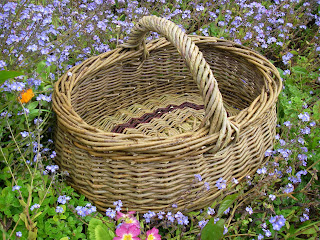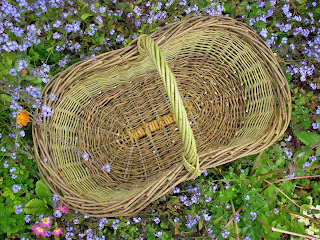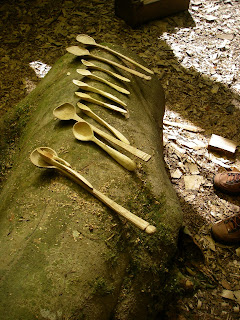I love this image of the parachute we use for shelter. In fairness it was probably more effective as shade than rain shelter this summer, but it is an excellent, cheap and easy to set up solution to shelter in the woods.
Thursday, 3 October 2013
Tuesday, 20 August 2013
Spooning
I find that my spoon-carving is like many things in life. My enthusiasm for it comes and goes for no particularly obvious reason, but I find myself having times of almost no carving, followed by periods of intense whittling and playing around with forms and ideas.
All sorts of things might prompt a period of carving, a new tool, finding some interesting wood, or even just sitting round a fire.
Spoon-carving is in a way a kind of sculpture, a playing with shape and form, but it is also in essence a practical thing, a prosaic and practical work of art perhaps (if that is possible...)? It involves making decisions about form, aesthetics, usability, practicality, use of material and probably lots of other things.
Making a spoon is on one hand a simple process, and yet it involves decision making on many different levels, a bit like life in general really..
Craft in general has, or can have this pleasing aspect of being focused on the basic and the physical, taking us out of the realm of the intellect and the world of electronic information. Or in other words, a great excuse to turn off the telly and do something creative with your own two hands.
Sunday, 4 August 2013
July courses
We have recently completed our first 9 day run of courses in Crenver grove. The whole thing went like a dream, blessed as we were with beautiful sunshine every day, plus a steady stream of the nicest folk we could have wished for.
Lin ran three different basketry courses, and I ran the spoon-carving course.
Here are some images of the various things we were doing.
We are resuming the courses in September. See the website for dates, prices and availability.
Saturday, 22 June 2013
Weaving ways
Here is some of Lin's recent beautiful work in willow.
 |
| Tall baskets with Lin's recently cut home-grown willow behind |
 |
| Spiral weaving |
 |
| Trad Irish skib |
 |
| Skeined shopping basket |
 |
| Nature's colours |
 |
| With pussy-willows |
These next are the result of a commission for four large lampshades for someone's home.
Gorgeous sculptural willow weaving, with organic flowing shapes. They are about 65cm tall.
 |
| Oval shopper |
 |
| Gathering basket |
 |
| Hourglass trug |
 |
| Willow flowers |
Regeneration
This is a snap of the stump of the Sweet chestnut tree we felled last winter for shingles. Already there is strong growth bursting from the base, searching out the light and space created by opening the forest canopy.
The coppicing of trees, if done well, is one of the few methods of husbandry that we do where the net result is largely beneficial for both ourselves and nature in general.
When a deciduous tree is felled during its dormant period (winter), it will regenerate itself the following spring, sending out many stems of new growth.
Cutting a tree in regular cycles can easily increase its life-span by three or four times, also massively adding to the amount of biomass it produces (material we, and other animals can use). This also means the tree locks up more carbon from the atmosphere.
Opening areas of the woodland canopy to sunlight increases growth of under-storey plants and flowers, encouraging insects, birds and mammals. Thus the biodiversity of native species is sustained over the centuries.
The woodland health and ecology is maintained, whilst providing us with fast growing material that can be used in myriad ways to produce countless practical items, shelter, fuel, food etc, not to mention areas of relative wildness essential to human emotional well-being.
Green woodworking and basketry are built on this system of coppicing and pollarding. Craftwork requires excellent quality material; clean, straight, long lengths of wood and withy that can be riven or woven. The coppiced tree uses the enormous energy stored in its root system, to push out new, multi-stemmed growth, and the individual stems must compete for light. The end result is the beautiful coppice wood we desire.
The trees we have felled could, in 10 or 20 years, be coppiced again, to make baskets, fencing, furniture, building timber and many other durable and pleasing things. We will have been involved in a genuinely renewable and sustainable process.
Not so long ago our entire country and much of Europe ran on the products and fuels from coppice woodland. Without fossil-fuels, trees and woodland would be the most important source of energy and material we have. Unlike fossil-fuels we can harvest them in a way that does not harm our ecology.
Trees are the most wonderful things we have at our disposal, and we cant live without them. We should celebrate them more, but understand that we don't need to just preserve them, like natures museum pieces in protected enclaves; they can provide us with almost everything we need if we use them wisely, and we worked out how to do that a long time ago.
Sunday, 5 May 2013
Laying the shingles
Over the winter we felled a really nice straight grained, knot free sweet-chestnut that should hopefully provide us with all the good quality stuff we need to complete the roof.
Once we have ringed a few sections of the trunk into 18 inch lengths, we split them initially with a maul and steel wedges.
The quartered sections are then split with a big froe and carried through the woods to the barn.
Chestnut has many great qualities, not least of which is the small amount of sap-wood present, meaning most of the wood is perfectly useable, and fit for long years exposure on a roof. Its natural durability, combined with its ease of riving makes it one of the best woods available in Cornwall for green woodworking.
While the team got stuck into making shingles, I got on with laying down some of the stock we made earlier in the year. I'm using 38mm copper nails to fix them as steel nails will corrode and rot out quickly with the combination of rainwater and the tannic acid in the wood.
Only 6 inches of the 18 inch shingle is exposed, meaning each run of them is covered with the next two successive ones. It is quite possible to be able to see light shining through chinks from the inside of a properly shingled roof, and have no leaks at all.
Only finished shingles are taken up on the roof but they still occasionally need a wee trim to make
them fit snuggly to their neighbour. A shingling hammer has a little hatchet blade on its back.
Work doesn't get much better than this really, sun on your back, birds singing, good wood and sharp tools. Of course doing this kind of project is massively labour intensive and is made enjoyable because of the team-work involved. It would be more of a slog on your own, but perfectly achievable given the time.
Subscribe to:
Comments (Atom)






































